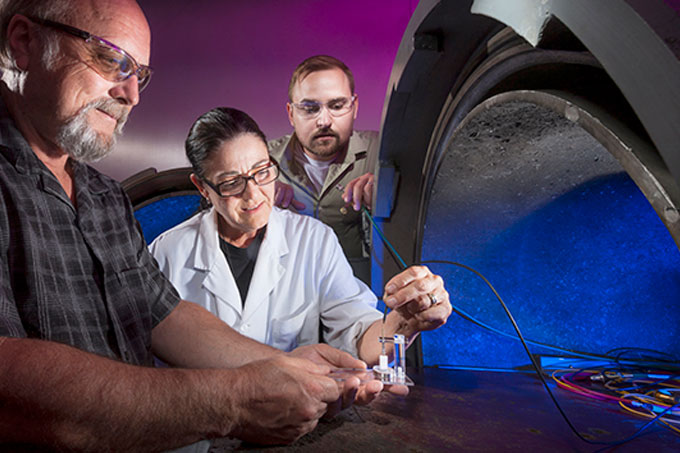At Lawrence Livermore National Laboratory (LLNL), we strengthen national security through world-class science, technology, and engineering. In an ever more rapidly changing world, this enduring mission requires informed anticipation, constant innovation, and disciplined delivery for the Department of Energy (DOE) and its National Nuclear Security Administration (NNSA). To quote the Laboratory’s founding director, Herbert F. York, our mission calls for “always pushing at the technological extremes.”
In another exceptional year, we fully met our programmatic and operational responsibilities, while establishing and extending our leadership in science and technology. This annual report highlights our many contributions in FY 2018 to making the nation—and the world—safer and more secure.
Our primary mission is to underwrite nuclear deterrence by helping ensure the safety, security, and effectiveness of systems in the U.S. nuclear weapons stockpile. We also provide the technology and expertise across the spectrum of weapons of mass destruction to enable high-confidence implementation of arms control, nonproliferation, and other threat reduction measures. We address deterrence more broadly as it intersects evolving threats in space, cyberspace, and missile defense; and we develop solutions for energy and climate security. We also help our nation’s leaders to understand new challenges and opportunities in a manner that is technically informed and sound.
But this is not all. When we have unique capabilities to bring to bear, we provide warfighter support; help respond to natural disasters; and contribute to advances in medicine, human health, and basic science that support DOE’s overall mission. As just one example, in FY 2018 an advanced LLNL biomedical technology that delivers vaccines and drugs inside the human body was licensed for use in cancer treatment.
As in past years, in FY 2018 we assessed the status of the W87 and W80 warheads and the B-83 gravity bomb. In addition, we are making excellent progress in a life-extension program (LEP) for the W80-4 warhead and restarting work on the W78. Both systems will benefit from updated safety features. Each is more than 30 years old and full of specialty parts that require replacement. Manufacturing processes have to be reinvented to supplant obsolete ones, and new parts must be tested and certified for long service life and for conditions ranging from icy cold to the center of the sun. And they have to be guaranteed to work in a system that cannot be tested and hopefully will never be used. We face and have met unique scientific and engineering challenges in carrying out these activities.
We continue to look beyond our immediate deliverables to anticipate future developments in an increasingly challenging security environment. Our Laboratory is part of the national “hedge” against the possibility that a sudden erosion in our nuclear security environment might require rapid modifications to our forces. We also play a fundamental role in ensuring that the nation has the competitive advantage in advanced technologies with potential military applications. Our robust science and technology base is a national asset, and in and of itself a crucial element of deterrence.
Carrying out our work for stockpile stewardship requires scientific tools and capabilities found nowhere else in the world, and they open new frontiers of scientific research. Our “bleeding edge” high-performance computers essentially allow us to simulate full-scale nuclear testing. Experiments at the National Ignition Facility (NIF) validate high-energy-density physics models. Complementing these flagship centers of excellence are unique capabilities for energetic materials research, radiography, and forensic science, among others.
This year we took delivery of and commissioned Sierra, the world’s second most powerful computer. Its workload includes the many classified simulations required for the W80-4 LEP. Sierra supports today’s mission needs and sets the stage for future paradigm shifts in computing: The next step, a ten-times faster exascale machine, is scheduled for delivery to LLNL in late 2022. Perhaps more revolutionary is the convergence of supercomputer modeling and machine learning, a phenomenon we call cognitive simulation. This step, already being explored on Sierra, will profoundly benefit our stockpile stewardship mission as well as a host of other scientific problems.
Experiments at NIF provided critical materials property data that informed the evaluation of options for the W80-4 LEP. NIF achieved a record-setting 2.1 megajoules of energy into the target chamber in FY 2018, and other tests continued to help scientists make significant progress toward achieving a burning plasma. Through basic science experiments, carried out by researchers from around the world, NIF has provided a means to study the cores of giant planets, simulated the physics of cosmic accelerators, and explored stellar nucleogenesis under realistic conditions.
The Advanced Manufacturing Laboratory opened in the Livermore Valley Open Campus, furthering the vision of innovation for our national security programs through strengthened collaborations with academic and industrial partners. Livermore is at the forefront in many areas of additive manufacturing, and Laboratory researchers are advancing micro- and nano-technologies for applications ranging from orbiting CubeSats (miniature satellites) for low-cost, high-resolution imaging from low-Earth orbit to biocompatible neural probes for monitoring brain activity.
Finally, our accomplishments this past year, as has always been the case, flowed from a world-class workforce committed to our values of developing new ideas, making a difference, embodying integrity and inclusiveness, and loving the work. By any metric of scientific progress, programmatic impact, or operational excellence, our people continue to set the highest bar.






